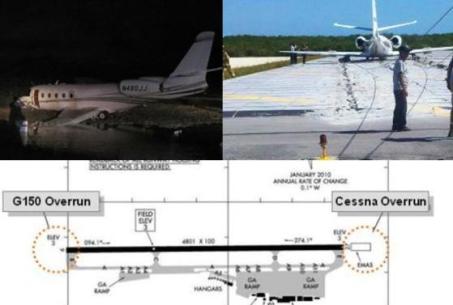Differing damage from two overruns by two business jets in a four-day span on the same runway in southern Florida, illustrates the benefits of a crushable concrete arresting pad that captured one of the two aircraft.
A Cessna 550 Bravo, landing on runway 9 at the Key West international airport on 3 November with five on board, overran the runway and travelled 44m (144ft) into a 104m-long engineered materials arresting system (EMAS) set back 11m from the runway end.
Preliminary estimates put the aircraft speed at 70-90kt (130-167km/h) on leaving the runway before entering the EMAS at the departure end of the runway. The opposite runway end does not have an EMAS.
"At touchdown the speed brakes extended but, when [the pilot in command] went to apply the wheel braking, there was no braking," said the NTSB in a preliminary report on the accident. "He then attempted to apply the emergency brake, but there was still no braking. The airplane then overran the runway."
None of the five on board the light jet - two pilots and three passengers - were injured, said the NTSB. Investigators said the aircraft received "minor damage", including separation of the nose-gear trunnion from the fuselage, left landing-gear door partially separated from the aircraft, and ingestion of dirt and dust by the two Pratt & Whitney Canada turbofan engines.
Investigators found no post-flight problems with the normal braking and anti-skid systems, although they did find the emergency braking/landing gear blow-down nitrogen bottle was empty.
The condition of the Cessna and its passengers after an EMAS save contrasts with an unaided overrun by a Gulfstream G150 midsize business jet with four on board, which landed in the opposite direction at Key West only four days earlier.
|
|---|
According to the NTSB, the pilot stated he touched down "just past" the 1,000ft marker on the 1,463m runway. He applied the brakes "and was going to activate the thrust reversers" when he realised the "brakes were not operating". "He took his feet off the brakes and then reapplied brakes with no response," the NTSB said.
The co-pilot's side brakes also failed to work, according to the report. The pilot then activated the thrust reversers.
"Examination of the crash site revealed the airplane departed the runway, crossed a 600ft (180m) overrun, impacted the far side of a ditch, crossed a dirt road, cleared another ditch, and came to a stop 820ft from the departure end of the runway," the NTSB said.
The G150's lose landing gear collapsed "and the airframe sustained structural damage", it added.
One of the passengers - NASCAR team owner Rick Hendrick - was treated for broken ribs and a broken shoulder, while the other three received minor injuries.
ESCO spokesman Kevin Quan said the Key West Cessna save is the eighth so far for the company, the only provider of EMAS systems. To date, ESCO has installed 67 EMAS pads around the world and is finishing an installation at the Teterboro airport in New Jersey.
Source: Flight International

















